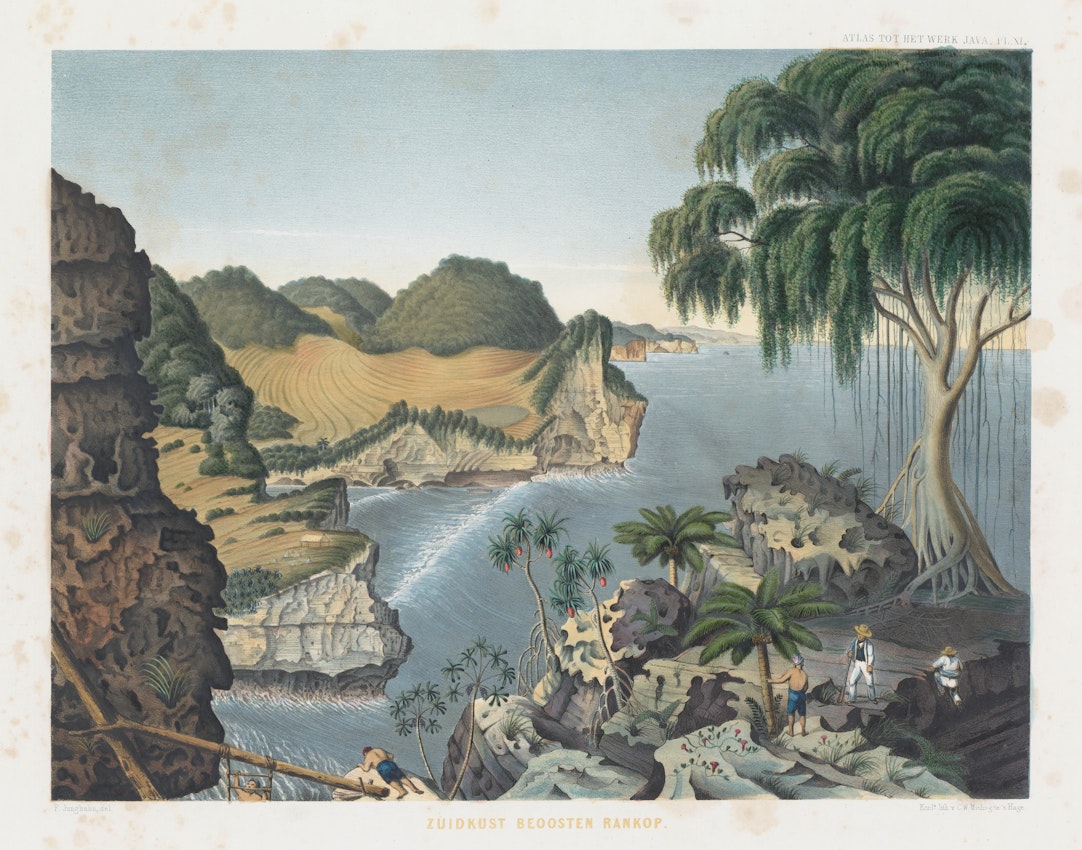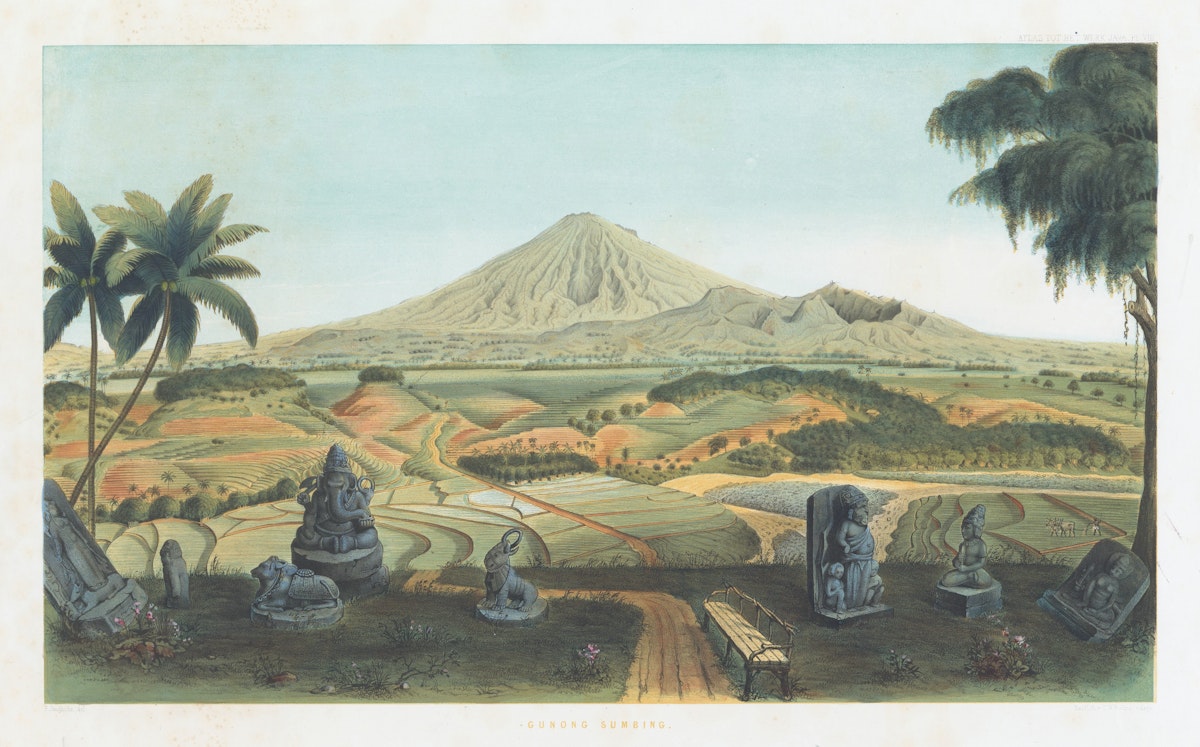
Lithographs from Franz Wilhelm Junghuhn’s Java-Album (1854)
Java-Album was printed from drawings by Franz Wilhelm Junghuhn to accompany a four-volume travelogue about his expeditions in the Dutch East Indies, published in 1854. The images were printed at great trouble — eleven color lithograph plates, with a twelfth tipped in as frontispiece to Volume 1— but they were not, by all accounts, appreciated by Junghuhn’s readers. Whereas the writing was judged literary, exuberant, and melodic, the renderings, as one critic wrote, “ha[ve] a hardness that makes the landscape look unnatural”. The sensuousness of Junghuhn’s prose apparently made his pictures feel sterile.
Born in Prussia in 1809, Junghuhn was one of those nineteenth-century polymaths whose name is trailed by a blitz of professions: geographer, linguist, botanist, volcanologist, physician, quinine farmer, mountaineer, cartographer, and “Java’s Humboldt”. He did not admire very many people (in fact, he did not like very many people), but the naturalist Alexander Humboldt was an exception, and this moniker would have pleased him.
Junghuhn arrived in Batavia (now Jakarta) around 1835 as a young man. He’d been forced by his father to study medicine, but then life stalled when he was jailed for fighting a duel. He escaped prison after a year and half, fled to France and joined the French Legion, but was discharged shortly after as unfit. Employment with the Dutch colonial government apparently had a low bar for entry. Junghuhn was hired as a doctor, though he proved a misanthrope without much aptitude for doctoring. After a few years, his superiors asked if perhaps he’d like to explore the mountainous interior of Java, which had never been mapped.
Any other European transplant would have thought this task too dangerous to merit consideration. The area was known as a roiling terrain of great heights and active volcanoes. Even the urban areas of the Dutch East Indies were considered life-threatening to Europeans, who were slow to acclimatize to the relative heat and humidity, especially when they clung to their Western dress. Junghuhn himself published an article claiming that within eight years of arrival, 90% of Europeans were either dead or sick. (Racist fears of miscegenation were not deeply buried; stay in your climate also meant stay with your race.) Add to the volcanoes and heat various storybook animals: crocodiles, wild pigs, monkeys, rhinoceroses, and scorpions — all which obsessed and terrified the Europeans. Tigers were so plentiful they prowled public plazas. Batavia may have been called “Jewel of Asia” and “Queen of the East”, but it was also called “Europeans’ Graveyard”.
Junghuhn, however, defiant and bristly by nature, decided that the expedition was a perfect assignment. He traveled for about twenty months, and despite many near-death experiences, rapturously enjoyed his time. In fact, he felt more contentment than he’d ever experienced before — his people weren’t people, it turned out, they were trees. Junghuhn wrote his travelogue after returning to Europe, though the drawings he claimed to have produced and colored in situ.
The vantage point of each is insistently high. Junghuhn’s affection for the aerial view, which he called the “instructive vista”, was born of many factors, including philosophical prerogative. Like Humboldt and Thoreau, he privileged the eye as the best teacher of all — better than books, better than tutors, better than hands. But also, he judged the elevated mountain climate more pleasant, the major flora more dignified, and the cultural traditions more refined than at lower elevations. (Tengger, Sumatran, and Sundanese villages were higher than those of the Javanese, who lived near sea level, and for whom Junghuhn had total contempt.) The Hindu Sundanese, for instance, surrounded their villages with tall hedges of bamboo, which Junghuhn found charming; the volcano they worshiped, the nearby Bromo, struck him as deserving of worship. Junghuhn came to the conclusion that height truly does equal greatness, and mapped his preferences accordingly. One could predict his fondness for specific plants, animals, and humans based on their level of elevation.
 Scroll through the whole page to download all images before printing.
Scroll through the whole page to download all images before printing.View of the south coast of Java
As the drawings show, the Dutch had already introduced the cultivation system in 1830, according to which Java’s lands were planted with cash crops that made a fortune for the colonial state by exploiting and starving the locals. Junghuhn’s mapping project was very much an arm of colonialist power, though he criticized the cultivation system loudly enough that he was reprimanded by the Governor-General. He also advocated socialism, and thought Christians shouldn’t be allowed to proselytize. One scholar describes him as “this most uncolonial of colonials”.
The critic who thought Junghuhn’s drawings “unnatural” and “hard” is not incorrect, but perhaps Junghuhn wasn’t aiming for naturalness. It’s possible that Java-Album’s stylized sterility was a deliberate effort to counter his audience’s assumptions that tropical landscapes are fetid, chaotic, uncontrollably profuse.
Nonetheless, Junghuhn takes many liberties. The volcanoes are tamed, the farming terraces spaced like lines on a ruler, the moss tendrils delineated. There is no indication that this place has a smell, or a temperature. Junghuhn presents the mountain Gamping as pristine, even though its limestone was being rapaciously mined, and he sets humans at the edges as if to indicate scale, not because this is their home.
Most conspicuous of all is the absence of fog: apparently ubiquitous in the areas where Junghuhn was traveling, it never appears in his pictures. He includes a few disciplined puffs of steam and a few billowy clouds, but absent entirely is the misty vapor that, on any given day, would have prevented Junghuhn from seeing clearly.
Find ten of Java-Album’s lithographs, courtesy of the Rijksmuseum, below. The eleventh image (of Mount Merapi) seems to be missing from their collection, so we have used an image held by Leiden University Library, courtesy of Wikimedia Commons, instead.
North coast near Semarang
View of the south coast of Java
Mount Gamping on Java
View of a landscape in Gunung Sewu
Sumbing volcano in Java
Crater lake of Mount Patoeha in Java
Guntur volcano in West Java
View of Lake Patenggang in Java
View of a landscape on the Dieng Plateau
View of Mount Gede
Mount Merapi
Feb 13, 2024









